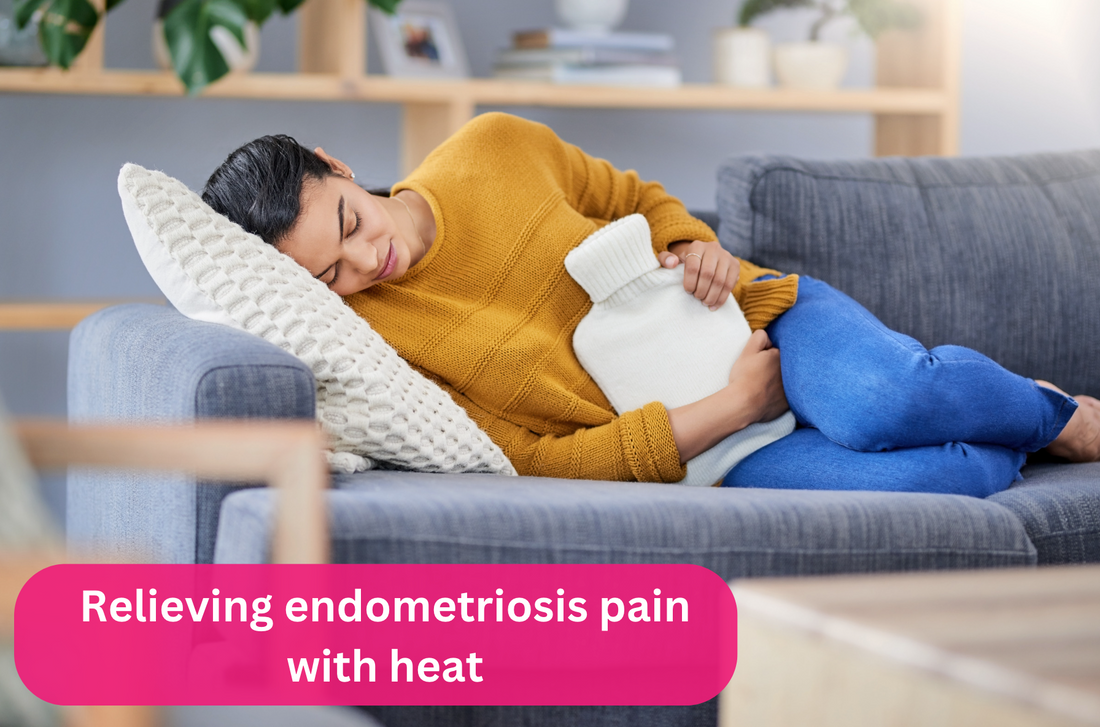
Pain relief for endometriosis using heat
Share
Understanding Endometriosis Pain
Endometriosis pain arises from the growth of endometrial tissue outside the uterus, leading to inflammation, scar tissue formation, and adhesions. This can result in:
- Dysmenorrhea: Painful menstrual cramps.
- Chronic Pelvic Pain: Persistent pain in the pelvic region.
- Dyspareunia: Pain during or after intercourse.
- Dyschezia: Painful bowel movements.
Inflammation and nerve involvement are significant contributors to the pain experienced by those with endometriosis. Heat therapy provides a natural means of managing this pain by promoting muscle relaxation and increasing blood flow.
How Heat Therapy Works
Heat therapy, also known as thermotherapy, involves applying heat to specific areas of the body. This can help alleviate pain through several mechanisms:
- Muscle Relaxation: Heat helps relax muscles, reducing spasms and tension in the pelvic area.
- Increased Blood Flow: Heat dilates blood vessels, improving circulation and helping to reduce inflammation.
- Endorphin Release: Heat stimulates the release of endorphins, the body’s natural painkillers.
- Reduced Nerve Transmission: Heat can slow the transmission of pain signals to the brain, providing relief.
Types of Heat Therapy for Endometriosis
There are several methods of applying heat therapy, each with its own advantages. Here’s a look at some of the most effective types for endometriosis pain:
1. Heating Pads
How to Use: Place a heating pad on the lower abdomen or back. Use it for 15-20 minutes at a time.
Benefits: Heating pads are portable, maintains consistent heat, often reaching very high temperature.
Cons: Restricts your movement and can be stiff and large. Needs to be used while resting or sitting down. Difficult in targeting specific smaller areas (i.e Vaginal Areas)
Tips: Choose a pad with adjustable heat settings to avoid burns, and never sleep with a heating pad on.
2. Warm Baths
How to Use: Soak in a warm bath for 20-30 minutes. Adding Epsom salts can enhance the soothing effects.
Benefits: A warm bath provides full-body relaxation and can help reduce stress, which often exacerbates pain.
Cons: Requires too much water, heats up the entire body including your head. Sometimes it may feel more like a chore than a soothing experiance.
Tips: Make sure the water is not too hot, as excessive heat can cause dizziness or skin irritation.
3. Hot Water Bottles
How to Use: Fill a hot water bottle and place it on the painful area. Wrap it in a towel to avoid burns.
Benefits: Hot water bottles are inexpensive and retain heat for an extended period.
Cons: Heavy and bulky. Poses a risk of leaking hot water, often causing burns. Difficult in targeting specific smaller areas (i.e Vaginal Areas). Mostly restrics movements.
Tips: Check for leaks and replace old or damaged bottles to prevent burns.
4. Microwavable Heat Packs
How to Use: Heat in the microwave according to the manufacturer’s instructions and apply to the affected area.
Benefits: These packs are reusable and light weight. Aura Wear gel packs affordable, targets heat specifically to painful uterus, ovaries and vaginal area. They are incredibly flexible, allows complete movement. They can even be heated up with boiling water or clothing iron!
Cons: Requires reheating after 1 hour.
Tips: Ensure even heating to avoid hot spots that could cause burns.
5. Infrared Heating Devices
How to Use: Use infrared heating devices as directed to target deeper tissues.
Benefits: Infrared heat penetrates deeper into tissues, can provide substantial pain relief for some users.
Cons: Expensive and bulky. Can get very hot. Not designed for vaginal cramping areas.
Tips: Follow safety instructions and limit exposure to avoid skin damage.
Benefits of Heat Therapy for Endometriosis
Heat therapy offers several benefits for managing endometriosis pain:
1. Non-Invasive and Drug-Free
Heat therapy is a non-invasive, drug-free option, making it a safe choice for those who prefer to avoid medications or who experience side effects from other treatments.
2. Ease of Use
Heat therapy can be applied at home without the need for specialized equipment. Most methods are straightforward and require minimal preparation.
3. Immediate Relief
Heat therapy often provides immediate pain relief, making it an excellent option for managing acute pain episodes.
4. Stress Reduction
By promoting relaxation and reducing muscle tension, heat therapy can help alleviate stress, which often exacerbates endometriosis pain.
5. Complementary to Other Treatments
Heat therapy can be used alongside other treatments, such as medications or physical therapy, to enhance overall pain management.
Practical Tips for Using Heat Therapy
While heat therapy is generally safe, here are some tips to ensure effective and safe use:
- Moderate Temperature: Avoid excessive heat. Warm is usually sufficient, and extreme heat can cause burns or worsen inflammation.
- Short Sessions: Limit sessions to 15-20 minutes at a time. Longer exposure can lead to skin irritation or burns.
- Hydration: Stay hydrated, especially when using heat over large areas or for extended periods.
- Monitor Skin: Check your skin regularly for signs of burns or irritation, especially if you have sensitive skin.
- Consistency: Use heat therapy consistently for ongoing pain management, not just during acute episodes.
Conclusion
Heat therapy is a simple, effective, and natural way to manage endometriosis pain. By incorporating methods like heating pads, warm baths, and hot water bottles into your routine, you can achieve significant relief from pain and improve your quality of life. Always consult with your healthcare provider before starting any new treatment to ensure it’s appropriate for your specific situation.

